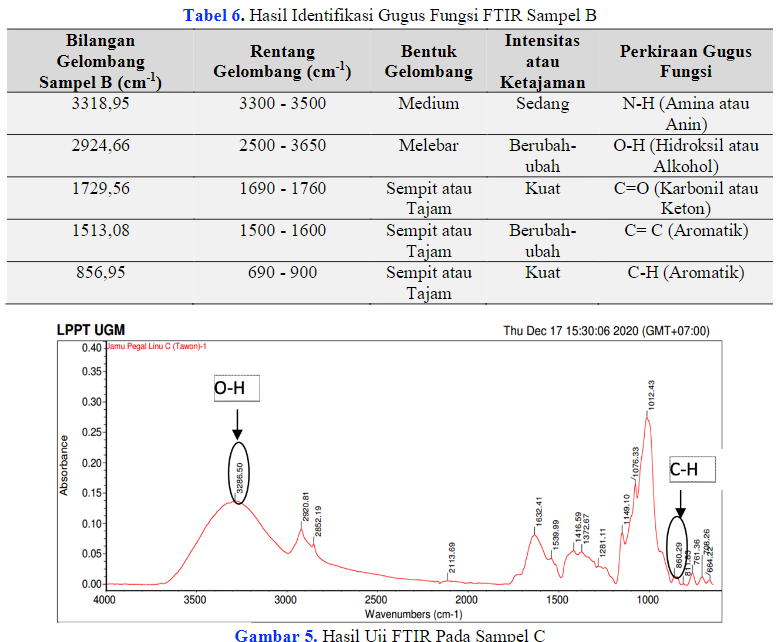Main Article Content
Abstract
Analgesic drugs are often added illegally in rheumatic pain traditional medicine. Paracetamol is one of chemical drugs that have a large possibillity to be added in rheumatic pain traditional medicine. The aims this research were to know paracetamol and concentration of paracetamol in rheumatic pain traditional medicine in Borobudur District. This research is experimental research, the analysis data were used microsoft excel and linear regression. Qualitative analysis method using organoleptic test to description the sample, TLC test to evaluation Rf value and FTIR test for characterization. Quantitative analysis method using LC-MS test to know the paracetamol concentration contained on the rheumatic pain traditional medicine. Organoleptic test the results show description the shape, color, smell and taste of sample A, B and C. The results of the TLC evaluation showed sample A and B were positive, indicated by a purple spot and the Rf value of the sample was exactly same compared to Rf value of standard paracetamol, while sample C is negative. The result of the FTIR spectra showed that sample A and B have same functional group as the standard paracetamol, while sample C showed none. LC-MS test results after calculating the concentration in samples A and C the concentration was obtained < 4,4 μg/kg below the Detection Limit (LoD): 4,4 μg/kg, while sample B the concentration was obtained 2,22%. Based on the results of all three samples tested, the sample A and sample B were positively contaminated by chemical medicine paracetamol while sample C were negative.
Keywords
Article Details

This work is licensed under a Creative Commons Attribution-NonCommercial 4.0 International License.
References
- BPOM, R. 2016. Bahaya Bahan Kimia Obat (BKO) yang Dibubuhkan ke dalam Obat Tradisional (Jamu) (2016). Jakarta. Retrieved from www.pom.go.id pada tanggal 5 April 2020.
- Efendi, R. P. (2017). Perlindungan Hukum Konsumen Atas Penggunaan Obat Tradisional Jamu yang Mengandung Bahan Kimia Berbahaya. Skripsi. Universitas Islam Indonesia. Yogyakarta.
- Farikha. (2016). Identifikasi Parasetamol dan Deksametason dalam Jamu Reumatik dengan Metode KLT dan Spektrofotometri UV di Pasar Minggu Palimanan Cirebon. Karya Tulis Ilmiah. Politeknik Kesehatan Bandung. Bandung.
- Farmakope. (2020). Farmakope Indonesia (Edisi VI). Jakarta: Departemen Kesehatan Republik Indonesia.
- Fatimah, S., Rahayu, M., & Indari, D. F. (2017). Analisis Antalgin dalam Jamu Pegal Linu yang Dijual di Pasar Beringharjo Yogyakarta. JoH, Vol.4,No.1.
- Ginting, M. K. (2012). Validasi Metode LC-MS/MS untuk Penentuan Senyawa Asam Trans, Trans-Mukonat, Asam Hippurat, Asam 2-Metil Hippurat, Asam 3-Metil Hippurat, Asam 4-Metil Hippurat dalam Urin Sebagai Biomarker Paparan Benzena, Toluena, dan Xilenia. Skripsi. Universitas Indonesia. Depok.
- Haeria, Musfikah, A., & Fitrah, M. (2015). Karakterisasi Kokristal Parasetamol - Asam Suksinat Melalui Metode Solvent Drop Grinding. JF FIK UINAM, Vol.2,No.3, 108–114.
- Handoyo, K. (2014). Jamu Sakti Mengobati Berbagai Penyakit. Jawa Timur: Dunia Sehat.
- Hayun, & Karina, M. A. (2016). Pengembangan dan Validasi Metode KLT-Densitometri untuk Analisis secara Simultan Parasetamol, Asam Mefenamat dan Ibuprofen dalam Jamu “Pegal Linu.” Jurnal Sains Farmasi Dan Klinis, 2(2), 150–161. Retrieved from https://jsfkonline.org.
- Indriatmoko, D. D., Rudiana, T., & Saefullah, A. (2019). Analisis Kandungan Parasetamol Pada Jamu Pegal Linu yang Diperoleh dari Kawasan Industri Kecamatan Kibin Kabupaten Serang. Jurnal ITEKIMIA ISSN: 2548-947x, Vol.5, No.1.
- LPPT. (2021). Laporan Kerja Uji Kimia. LPPT UGM. Yogyakarta.
- Mangurana, W. O. I., Yusnaini, & Sahidin. (2019). Analisis LC-MS/MS (Liquid Crhomatogaph Mass Spectrometry) dan Metabolit Sekunder serta Potensi Antibakteri Ekstrak n-Heksana Spons Callyspongia aerizusa yang diambil pada kondisi tutupan Terumbu Karang yang berbeda di Perairan Teluk Staring. UPT Mataram U. Jurnal Biologi Tropis, 19 (2), 131–141. https://doi.org/10.29303/jbt.v19i2.1126.
- Permatasari, D. A. I., Ritmaleni, & Nuryastuti, T. (2021). N-(2-chlorobenzyl) formamide , a Novel Synthesized Antituberculosis Evaluation by Microplate Alamar Blue Assay. Research J. Pharm. and Tech., 14(6):3253.
- Saputra, S. A. (2015). Identifikasi Bahan Kimia Obat dalam Jamu Pegel Linu Seduh dan Kemasan yang Dijual di Pasar Bandar. Jurnal Wiyata, Vol.2,No.2.
- Striegel, F. M., & Hill, J. (1958). Thin-Layer Chromatography for Binding Media Analysis. Los Angeles: Scientific Tools for Conservation. The Getty Conservation Institute.
- Susilawan, I. P. N. A., Siaka, I. M., & Parwata, I. M. O. A. (2018). Validasi Metode Analisis Bahan Kimia Obat Parasetamol dan Fenilbutason pada Produk Obat Tradisional dengan HPTLC-SPEKTROFOTODENSITOMETRI. Jurnal Cakra Kimia, Vol. 7, No.1.
- Tambunan, E. Y. B. (2020). Penetapan Kadar Campuran Parasetamol dan Ibuprofen dalam Sediaan Tablet Secara Spektrofotmetri Inframerah (FTIR). Skripsi. Universitas Sumatera Utara. Medan.
- Wijianto, B., & Yumanda. (2012). Analisis Kandungan Parasetamol Pada Jamu Pegal Linu di Pontianak dengan Menggunakan Metode Kromatografi Lapis Tipis (KLT) dan Spektrofotometri UV-Vis. Jurnal Penelitian, XXVI.
